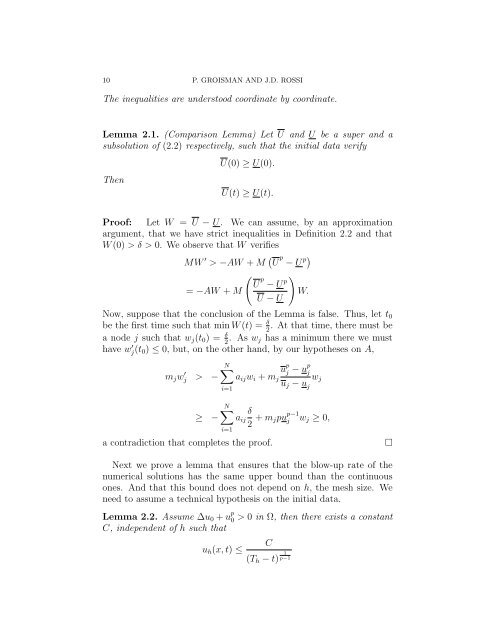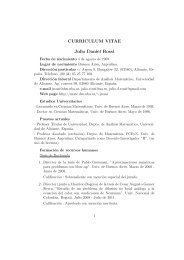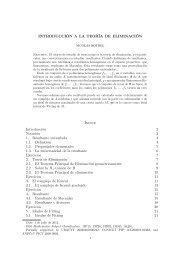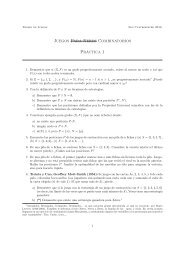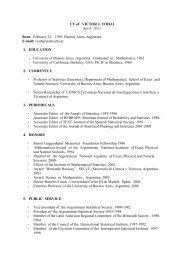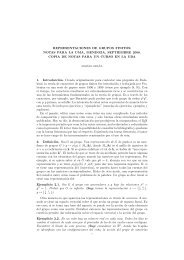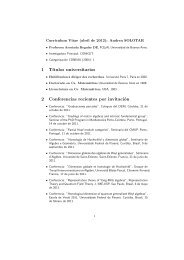Dependence of the blow-up time with respect - Universidad de ...
Dependence of the blow-up time with respect - Universidad de ...
Dependence of the blow-up time with respect - Universidad de ...
You also want an ePaper? Increase the reach of your titles
YUMPU automatically turns print PDFs into web optimized ePapers that Google loves.
10 P. GROISMAN AND J.D. ROSSI<br />
The inequalities are un<strong>de</strong>rstood coordinate by coordinate.<br />
Lemma 2.1. (Comparison Lemma) Let U and U be a s<strong>up</strong>er and a<br />
subsolution <strong>of</strong> (2.2) <strong>respect</strong>ively, such that <strong>the</strong> initial data verify<br />
Then<br />
U(0) ≥ U(0).<br />
U(t) ≥ U(t).<br />
Pro<strong>of</strong>: Let W = U − U. We can assume, by an approximation<br />
argument, that we have strict inequalities in Definition 2.2 and that<br />
W (0) > δ > 0. We observe that W verifies<br />
MW ′ > −AW + M U p − U p<br />
<br />
U<br />
= −AW + M<br />
p − U p<br />
<br />
W.<br />
U − U<br />
Now, s<strong>up</strong>pose that <strong>the</strong> conclusion <strong>of</strong> <strong>the</strong> Lemma is false. Thus, let t0<br />
. At that <strong>time</strong>, <strong>the</strong>re must be<br />
be <strong>the</strong> first <strong>time</strong> such that min W (t) = δ<br />
2<br />
a no<strong>de</strong> j such that wj(t0) = δ<br />
2 . As wj has a minimum <strong>the</strong>re we must<br />
have w ′ j(t0) ≤ 0, but, on <strong>the</strong> o<strong>the</strong>r hand, by our hypo<strong>the</strong>ses on A,<br />
mjw ′ j > −<br />
≥ −<br />
N<br />
u<br />
aijwi + mj<br />
i=1<br />
p<br />
j − <strong>up</strong>j<br />
wj<br />
uj − uj N<br />
i=1<br />
δ<br />
aij<br />
2<br />
p−1<br />
+ mjpuj wj ≥ 0,<br />
a contradiction that completes <strong>the</strong> pro<strong>of</strong>. <br />
Next we prove a lemma that ensures that <strong>the</strong> <strong>blow</strong>-<strong>up</strong> rate <strong>of</strong> <strong>the</strong><br />
numerical solutions has <strong>the</strong> same <strong>up</strong>per bound than <strong>the</strong> continuous<br />
ones. And that this bound does not <strong>de</strong>pend on h, <strong>the</strong> mesh size. We<br />
need to assume a technical hypo<strong>the</strong>sis on <strong>the</strong> initial data.<br />
Lemma 2.2. Assume ∆u0 + u p<br />
0 > 0 in Ω, <strong>the</strong>n <strong>the</strong>re exists a constant<br />
C, in<strong>de</strong>pen<strong>de</strong>nt <strong>of</strong> h such that<br />
uh(x, t) ≤<br />
C<br />
(Th − t) 1<br />
p−1


